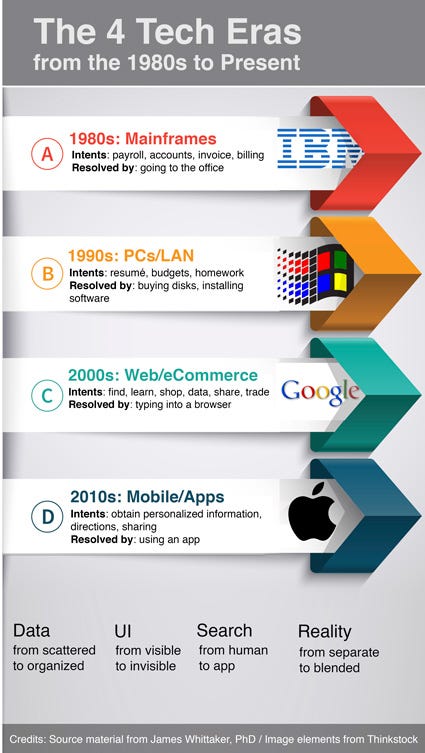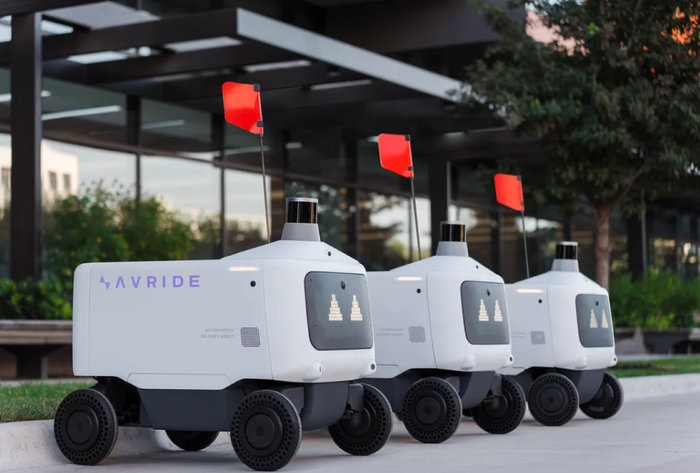How to Predict the Future
Technology is fated to resolve our intents automatically, says a senior Microsoft spokesperson.
March 24, 2017

Think you can’t predict the future? Think again, says Microsoft’s distinguished technical evangelist James Whittaker, PhD. “The future is already staring us in the face,” he explained at the IoT in Action conference in San Jose.
Powerful technologies tend to quietly incubate for about a decade until they change the world, Whittaker says. This general principle has held true since the 1980s. In the past few decades, we’ve witnessed four distinct technical eras. Mainframes, PCs, the internet, and mobile all popped up, sending shockwaves rippling through society. None of those technologies, however, were new when they conquered the world. To understand what’s next, we need to ponder how we got here.
The Mainframe Era Gives Way to the PC Age
 In the 80s, IBM was king and mainframes ruled the land, becoming essential tools for payroll and accounting. But then, the PC pops up and decimates the mainframe market in the 90s. PCs weren’t new, however. Heck, Time magazine declared the personal computer to be its “Machine of the Year” back in 1982.
In the 80s, IBM was king and mainframes ruled the land, becoming essential tools for payroll and accounting. But then, the PC pops up and decimates the mainframe market in the 90s. PCs weren’t new, however. Heck, Time magazine declared the personal computer to be its “Machine of the Year” back in 1982.
But suddenly in the era of grunge music, PCs became a need-to-own item. Now, instead of driving to the office to use a mainframe, you could go to your personal computer in the living room. All consumers had to do was buy a PC and install the software they want for doing everything from building home budgets to resumés to playing Wolfenstein 3D. Kids suddenly had a new tool at their disposal for writing up reports or learning how to program. “It was homework that allowed Microsoft to succeed in their ambitious corporate mission,” Whittaker quips. “If you want to get filthy rich, sell something to people who have recently procreated. They will buy anything to make sure their kids don’t fall behind.”
E-Commerce Emerges
Microsoft had a good run until the web and e-commerce era dawned around the turn of the century—about a decade after the invention of the World Wide Web in 1989. Now, the internet enables people to resolve different intents than they could in the PC age. They can find information on nearly any subject, shop without leaving their house, trade stocks with a few clicks, and connect with people across the world without getting in a plane. “Now, there’s no more installing software,” Whittaker says. “All I have to do is point my browser at something.” This combination of convenience and new capabilities fueled the ascent of companies like Google, Amazon, Facebook, and eBay.
The Mobile Age Dawns
When Apple launched the iPhone in 2007, not everyone was impressed. Several tech pundits predicted the phone would be a flop. But with smartphones, you now had technology to help you find answers for new intents. “Remember back when we used to print driving directions and take them in our car with us? That is the web era,” Whittaker says. Thanks to mobile, you can have your intent resolved by an app rather than a website. “You can tell an app who you are, what you like, what your favorite teams are, and get your news from an app,” Whittaker says. “Not good for Google. Very good for Apple.”
The Data-Powered Future
So, which technology has been around for a decade that is poised for primetime now? Data, Whittaker says. “You think: ‘Oh, in the 1980s, we had a lot of data—we keyed it all into the mainframe. And in the 1990s, we had data. Our programs used it,” he adds. “No, we had information. We have data now.”
AI is BS. There is nothing artificial about it and nothing intelligent about it.
The cloud defined what data is today, Whittaker says. Having data all in the same place is what makes algorithms seem so magical. “AI is BS. There is nothing artificial about it and nothing intelligent about it,” Whittaker says. “AI should stand for ‘algorithmically impressive’ because it is the data [that’s powerful].”
The notion of cloud-based data is already a decade old. Amazon launched its enterprise cloud back in 2006. “That caught us all by surprise. We thought they were building a bookstore,” Whittaker says. “We kept telling them: ‘Dude, you aren’t selling enough books.’” In 2016, Amazon’s cloud business hit $12 billion in revenue.
Resolving Desires Automatically Kills UI and Apps
The other promising technology that is ready for prime time is machine-initiated search, Whittaker explains. “Think about it: Those apps on your iPhone are searching the web and are finding answers and data for you,” Whittaker says. In the future, technology can pick up consumers’ intent by picking up voice commands or simply conclude what they want to accomplish from data.
Take the screen out of the equation—no UI is acceptable.
“Now, I have to tell my smartwatch that I want to go run. Why? That is so 2017!” Whittaker says. “We need to stop waiting for humans to provide the input. Recognize the fact that I am on the same trail that I’ve been on for the past year and recognize my speed.” The intents are there already. “We are just not collecting them,” Whittaker explains.
Instead of writing apps or designing a UI to capture those intents, technology builders should understand how machines and data in the cloud can resolve human intent. “This is your path to implementing the Internet of Things. Take the screen out of the equation—no UI is acceptable,” Whittaker explains.
Ultimately, you can get to the future by following five steps, Whittaker says. First, determine the intents that you and your customers have. Second, understand how those intents first occurred. Third, build the machines to capture those intents. Fourth, locate the data to resolve them. Finally, deliver amazing personalized experiences.
“It’s going to take some epic shit to get this done,” Whittaker concludes.
About the Author
You May Also Like






